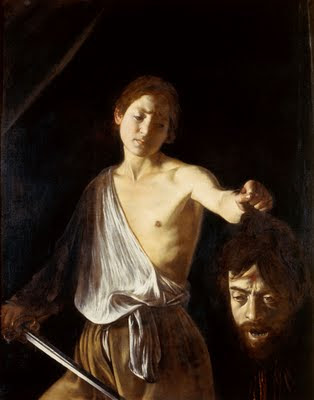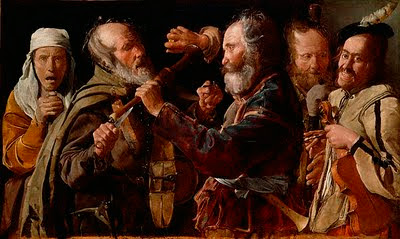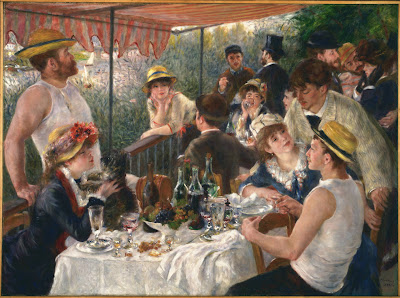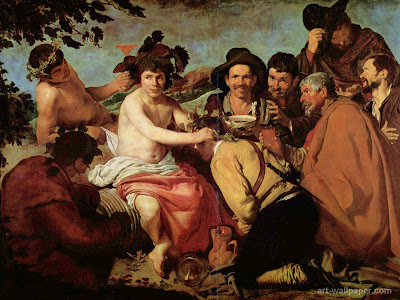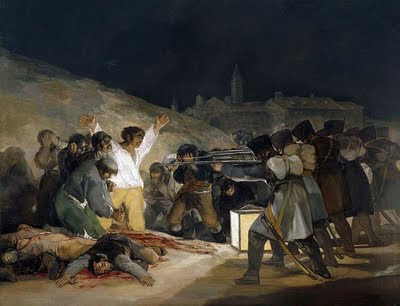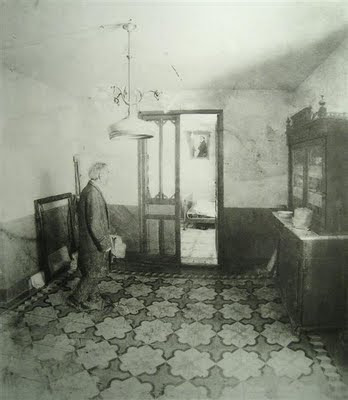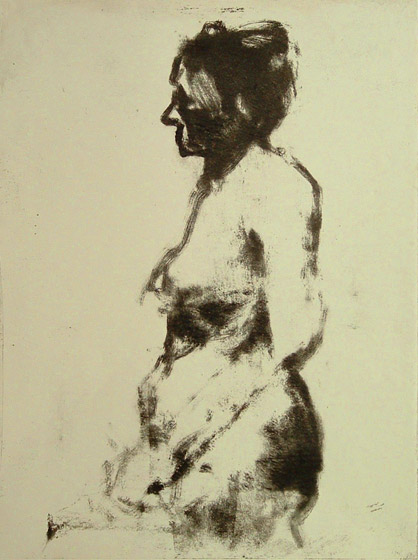"Genre" is an art form that deals with figures engaged in mundane situations: working, playing, partying etc. Images of everyday life can be found throughout the history of art, but Genre as an art form saw its greatest prominence in 17th century Holland where new social and economic conditions bred a voracious appetite for such depictions of everyday life. Jan Steen, Vermeer, Gerard Ter Borch, Dirk Bouts, and hundreds of other artists of that century, delighted in the routine details of daily life, and often wove subtle morality tales into their compositions.
 |
| The Card Game Argument, Jan Steen, Dutch 17th c. |
 |
| Jan Steen |
 |
| Celebrating the Birth, Jan Steen |
 |
| The Bean Feast, Jan Steen |
 |
| A Guard Room Interior, Gerard Ter Borch, Dutch 17th c. |
As an official category of the French Academy, Genre occupied an inferior place in the art hierarchy, beneath portraiture, religious, allegory and history painting. Jean-Baptiste Simeon Chardin's paintings of domestic interiors, card playing, and children blowing soap bubbles are landmarks of genre painting in their frank, direct paint handling and keenness of observation of light on natural form, as well as in his attention to the subtle repetitions and geometries with which he constructs his compositions.
 |
| Boy Blowing Soap Bubbles, Chardin, French 18th c. |
 |
| Girl With a Shuttlecock, Chardin |
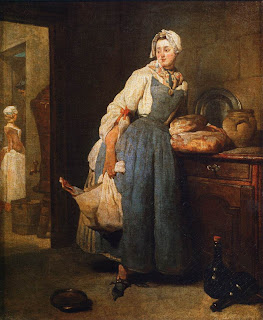 |
| The Provider, Chardin |
Championed by writers and philosophers like Emile Zola, artistic depictions of familiar, everyday realities flourished anew in the hands of such artists as Edgar Degas. As a young artist Degas emulated the great masters of figure painting and attempted several history paintings of his own before his own fascination with the pageantry of contemporary life claimed his artistic ambitions. Degas created some of his most powerful images mining the quotidiana of life: the racetrack, the ballet, the cafe` society of Paris, milliners' shops, and brothels, among other subjects.
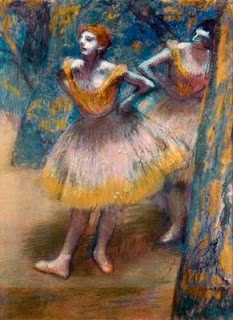 |
| Degas |
 |
| Degas |
 |
| The Absinthe Drinkers, Degas |
 |
| Degas |
Themes of daily life can also be found in Japanese Ukiyo-e prints which flooded into Europe in the mid-19th century and influenced many artists, including Degas, with their essential flatness, lack of linear perspective, and unusual viewpoints and compositional cropping.
 |
| Great Horse Race, Yoshu Chikanobu |
 |
| detail |
As artists moved toward abstraction in the 20th century, driven by the idea of "purifying" art of narrative content, Genre as a motive for art became suspect and atrophied to the point of extinction except in the hands of die-hard realists like Reginald Marsh, Isabel Bishop, and Edward Hopper.
 |
| Nighthawks, Edward Hopper |
 |
| Sketch for Nighthawks, Edward Hopper |
 |
| Edward Hopper |
 |
| Coney Island, Reginald Marsh |
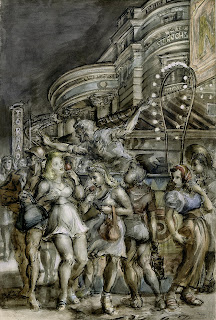 |
| Coney Island, Reginald Marsh |
 |
| Reginald Marsh |
 |
| Isabel Bishop |
Late in the 20th century many artists began questioning the Modernist dogmas of formal "purity,"and returned to representational art in force, bringing with them a renewed interest in narrative content. In a drawing symposium at Randolph-Macon Womans College in the 1990's, artist Janet Fish remarked on the so-called "return" to the figure, saying, "...isms come and isms go, and the realists just go on making art..," suggesting that, in fact, interest in the figure had never disappeared.
Some contemporary artists:
Artist David Levine (1926-2009), like Daumier in 19th c. Paris, distinguished himself with his caricatures of contemporary politicians, writers, and entertainers, but he also made paintings and watercolors of the Coney Island beach culture. Levine, a student of Genre, said of his art, "There's great pickings in what's been left behind."
 |
| Coney Island, David Levine |
 |
| Coney Island, David Levine |
Robert Birmelin's depictions of urban life express the kinetic, fragmentary nature of experience through a transparent fusion of multiple figures in motion that have some of the character of double exposure. Critic Donald Kuspit, writing in Artforum magazine had this to say about the artist:
“Birmelin’s paintings are brilliant in the way they confront us with a variety of urban spaces and surfaces, including human surfaces. His is a tough-minded realism – these are not a tourist’s pictures. They flatter no one, and are full of psychological as well as material detail.”
 |
| Robert Birmelin |
 |
| Robert Birmelin |
 |
| Reversible Vectors, Robert Birmelin |
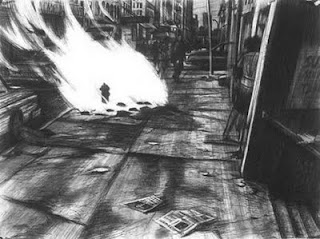 |
| Fire on 7th Avenue, Robert Birmelin |
Eric Fischl often weaves subtle social commentary into his work, as in this large diptych painting that contrasts a hedonistic scene on the left with a tragedy in the third world as if to confront the viewer with a moral question.
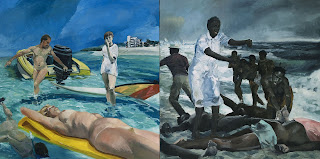 |
| Eric Fischl |
Virginia painter Phillip Geiger constructs complex domestic interiors with multiple figures by focusing on the discoveries and visual surprises that are to be found by careful observation of light and space. Geiger's figures are absorbed in their activities but, unlike Fischl's painting above, leave the narrative open to interpretation.
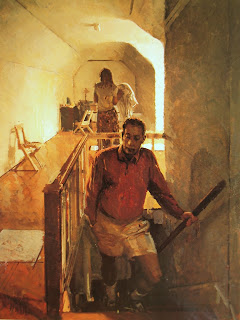 |
| Phillip Geiger |
 |
| Phillip Geiger |
Washington, DC, painter and printmaker Lee Newman creates compelling, small-scale images out of familiar situations, such as this drypoint engraving of an "eater" in a fast food restaurant. Newman draws on-site but just as often takes his metal plates and executes his engravings on the spot. Here his location was a local Roy Rogers restaurant where he worked directly from the mirrored reflections of diners in the plate glass windows. Behind her super-sized Coke, with a French fry poised in her upraised hand, Newman's figure incisively captures a small piece of life being lived.
 |
| Lee Newman, drypoint engraving |
Carlton Fletcher, another DC painter/printmaker, turns his eye often to contemporary situations involving single or multiple figures. The monotype below, a dancer in a seedy bar near the studio the artist once occupied near the Smithsonian's Portrait Gallery, has some of the voyeuristic qualities of Degas in the unselfconscious absorption of the dancer in a private moment. Another all-too familiar scene of contemporary life plays out in the painting that follows. Fletcher confronts the troubling realities of street gang violence in Washington, DC, endowing the tragedy with the gravitas of history painting.
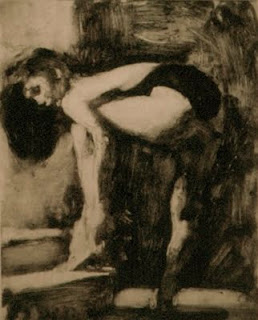 |
| Carlton Fletcher, monotype |
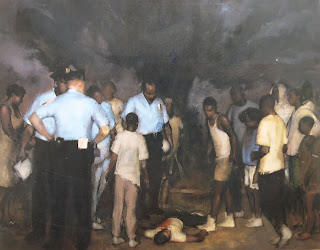 |
| Carlton Fletcher |
David Holt of Toronto, like Lee Newman, makes forays into genre that are fused with abstract concerns for the geometries of composition, the relationship between the figure and its space, and the process of mark-making and gesture.
 |
| David Holt, drypoint |
 |
| Flea Market, David Holt, drypoint |
Sangram Majumdar states that his paintings and drawings "are rooted at the intersection of perception and invention, light and form, and the elusive nature of reality." His almost life-size charcoal drawings are dense with figures moving through spaces that suggest urban transit systems such as subways or train stations. Majumdar realizes his compositions by an astute reading of the spatial relationships between figures and space, and also the tonal hierarchy of the whole. Figures merge and emerge from the charcoal ground, delicately balanced between solidity and dissolution, alluding to the movement of time through the movement of figures.
 |
| Sangram Majumdar |
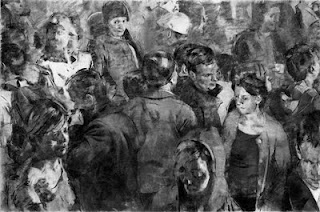 |
| Sangram Majumdar |
 |
| Sangram Majumdar |
Revisiting the traditions of genre is but one of many compelling veins of figural art that artists are mining today. What unites the diverse practices of artists working with the form today is an interest in the expressive potential of the human figure as both form and content. Though genre is often tainted with a whiff of the Academy, the best contemporary artists working with genre do so with an intelligent awareness of art history and attention to the formal language of art and composition.
Contemporary artists' websites:
